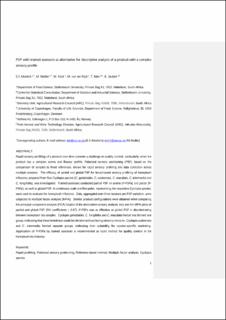| dc.contributor.author | Moelich, E.I. | |
| dc.contributor.author | Muller, M. | |
| dc.contributor.author | Kidd, M. | |
| dc.contributor.author | van der Rijst, M. | |
| dc.contributor.author | Næs, Tormod | |
| dc.contributor.author | Joubert, E. | |
| dc.date.accessioned | 2022-12-05T08:39:11Z | |
| dc.date.available | 2022-12-05T08:39:11Z | |
| dc.date.created | 2022-09-05T13:49:17Z | |
| dc.date.issued | 2022 | |
| dc.identifier.issn | 0950-3293 | |
| dc.identifier.uri | https://hdl.handle.net/11250/3035767 | |
| dc.description.abstract | Rapid sensory profiling of a product over time presents a challenge in quality control, particularly when the product has a complex aroma and flavour profile. Polarized sensory positioning (PSP), based on the comparison of samples to fixed references, allows for rapid sensory profiling and data collection across multiple sessions. The efficacy of partial and global PSP for broad-based sensory profiling of honeybush infusions, prepared from five Cyclopia species (C. genistoides, C. subternata, C. maculata, C. intermedia and C. longifolia), was investigated. Trained assessors conducted partial PSP on aroma (P-PSPa) and palate (P-PSPp), as well as global PSP. A continuous scale and five poles, representing the respective Cyclopia species, were used to evaluate the honeybush infusions. Data, aggregated over three sessions per PSP variant, were subjected to multiple factor analysis (MFA). Similar product configurations were obtained when comparing the principal component analysis (PCA) bi-plot of the descriptive sensory analysis data and the MFA plots of partial and global PSP (RV coefficients ≥ 0.87). P-PSPa was as effective as global PSP in discriminating between honeybush tea samples. Application of PSPa by trained assessors is recommended for quality control in the honeybush tea industry: in this variant of PSP assessors focus on one modality, thereby potentially reducing sensory fatigue. Cyclopia genistoides, C. longifolia and C. maculata herbal teas formed one group, indicating that these herbal teas could be blended without losing sensory character. Cyclopia subternata and C. intermedia formed separate groups, indicating their suitability for species-specific marketing. | |
| dc.language.iso | eng | en_US |
| dc.subject | Reference based method | |
| dc.subject | Reference based method | |
| dc.subject | Rapid profiling | |
| dc.subject | Rapid profiling | |
| dc.subject | Cyclopia species | |
| dc.subject | Cyclopia species | |
| dc.subject | Polarised sensory positioning | |
| dc.subject | Polarised sensory positioning | |
| dc.subject | Multiple factor analysis | |
| dc.subject | Multiple factor analysis | |
| dc.title | PSP with trained assessors as alternative for descriptive analysis of a product with a complex sensory profile | en_US |
| dc.title.alternative | PSP with trained assessors as alternative for descriptive analysis of a product with a complex sensory profile | en_US |
| dc.type | Journal article | en_US |
| dc.type | Peer reviewed | en_US |
| dc.description.version | submittedVersion | |
| dc.source.volume | 103 | en_US |
| dc.source.journal | Food Quality and Preference | en_US |
| dc.identifier.doi | 10.1016/j.foodqual.2022.104704 | |
| dc.identifier.cristin | 2048893 | |
| dc.relation.project | Norges forskningsråd: 314111 | |
| dc.relation.project | Nofima AS: 202102 | |
| dc.relation.project | Norges forskningsråd: 314318 | |
| dc.relation.project | Nofima AS: 202103 | |
| cristin.ispublished | true | |
| cristin.fulltext | preprint | |
| cristin.qualitycode | 1 | |
